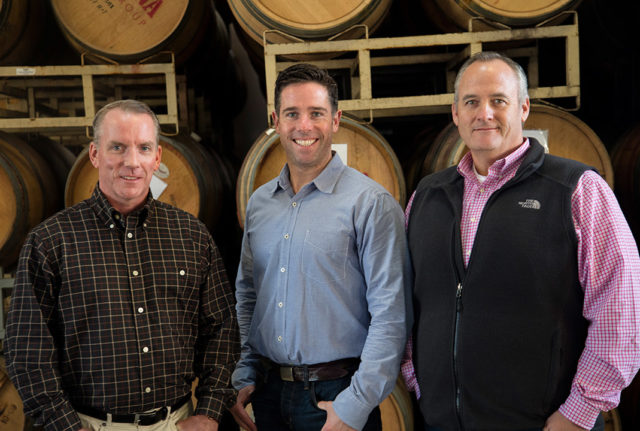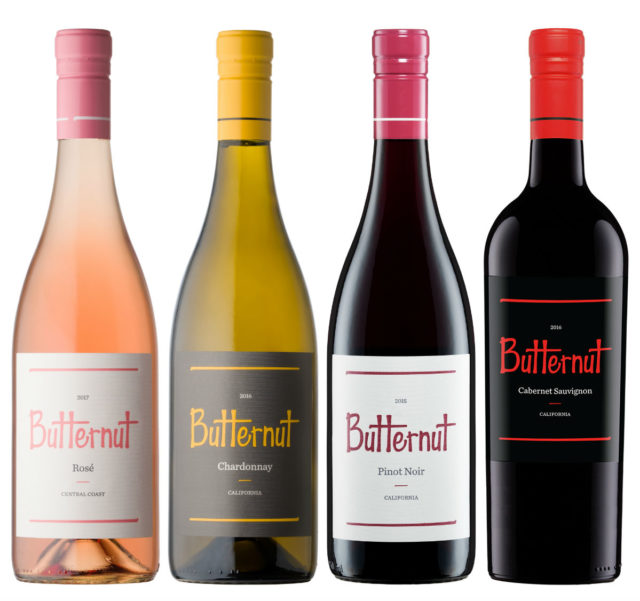By Paul Vigna
While there are no questions any more about Butternut Wines’ prominent spot in the marketplace and its soaring potential, Tony Leonardini admits that he and his partners had some doubts about the timing when they created the brand.
A winemaker, Leonardini says he and partners John Hooper and Gary Carr began developing the brand around a buttery Chardonnay at the time when a group called In Pursuit of Balance was gaining steam.

Left to Right: John Hooper, Tony Leonardini, Gary Carr
“It was this low-alcohol, no-oak, really fresh kind of natural wine and we were starting Butternut, which is the total opposite, you know, oak, butter,” he recalls. “We’re thinking, are we doing the right thing? So we started another brand called Bandwagon, a stainless-steel Chardonnay, no oak, a little bit of creaminess, really crisp. Well, that brand went away after three or four years and Butternut just took off.”
Butternut is one of the fastest growing brands in its category, showing double-digit growth over the past three years. Founded in 2011, with an initial offering of 1,500 cases, it exceeded sales of 100,000 cases in 2018 and projects growth in excess of 40% in 2019.
Anchored by Republic National Distributing Company USA, which distributes Butternut wines in 17 states, BNA Wine Group has established a strong nationwide distributor network that, through commitment and focus, continues to accelerate its growth. While BNA features four lines, Butternut is its cash cow, at a suggested retail price of $14.99 for a 750ml bottle and $6.99 for a 375ml can.
Leonardini grew up in California and worked in the family’s wine business through college. In his late teens, he experimented with winemaking and after earning his business degree started Little Lion Wine Company, releasing a Cabernet Sauvignon called Volunteer.

That set the current success in motion, with his wine finding an appreciative audience in Tennessee, nicknamed the Volunteer State. It’s where he met Carr, an industry veteran, and Hooper, a fourth-generation wine distributor and the early financial backer for BNA, which is based in Nashville while production remains in California.
As for the origins of Butternut, the winemaker credits his brother-in-law, who had 20 to 30 barrels of Chardonnay sitting around with no takers and no time to label and sell it. Offered the wine, Leonardini immediately accepted. “I had no name. I just liked the wine,” he says, adding that right then his wife walked into the house with a box of butternut squash. “And the light went off,” he says, “Wow, how great is that? Buttery and oaky. It describes the wine. I Googled it, and nothing came up. It was on.”
They immediately sought out markets where they thought the wine would do well, Leonardini says, ticking off the states: Florida; Alabama; Mississippi; Tennessee. “We just started getting distribution as fast as we could,” he recalls.
Carr says one of the more important steps the group took was to add new product, as distributors were responding to the name and recognizing it as a brand. “Making that decision really paid off and allowed us to produce a Pinot Noir, Rose and Cabernet in the Butternut family,” he says, “Since then, we have incorporated cans and changed the packaging on the bottles to have a Stelvin closure. All of these expansions have been a result of listening to our distributors and paying close attention to market trends.”

Of the four lines, Butternut accounts for 80 to 90 percent of the company’s business. Available in every state, Leonardini says it has done best in beach communities around the country, and in the Southwest. While the other varietals have done well – they have been pleasantly surprised by the success of their canned Pinot – the go-to for a majority of customers has been the full-bodied Chardonnay.
“I think it really shows what the consumer is looking for,” he says. “It’s like it you’re making a pasta dish or something, you’re not going to just throw salt in the water and then throw your pasta in. You are going to add oregano and garlic powder and garlic, whatever. I think it’s the same thing with Chardonnay. You kind of want to go to that spice rack to give that consumer a memorable experience.”
With the principal consumer largely the same ones heading weekly to the supermarket, it makes sense that BNA Wine Group have developed great relationships with chains such as Whole Foods, Kroger and Publix, among others. “Those have become really good partners for us, because we really recognize that demographic,” he says.
And as consumers keep buying, the company continues to seek expansion. Reached in California, Leonardini says he was headed to Colorado and then Nevada the following week. “You take your foot off the gas, someone else is taking that place on the shelf. So we just gotta stay on it.”

















